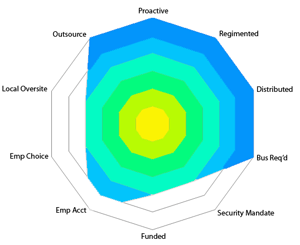Dimensions of a Mobility Management Strategy
What does your Mobility MRI Look Like?
While every mobility management strategy likely has cost containment at its core, the points of emphasis in each strategy can be as diverse as company cultures across the industry. For some, the wireless device is considered a company perk and comes with few restrictions and might in rare circumstances be extended to family members of an employee. For others there are strict cost guidelines and even stricter security requirements. This can result in only critical employees receiving company devices with limitations for business use only. The outcome for some employees is the need to carry around two wireless phones, one for business and one for personal use. Yet other companies have chosen to shift the entire burden of mobility management to employees. For some that privilege come s with a stipend and for others it does not.
s with a stipend and for others it does not.
A solution that fits one company like a glove may be a misfit for another based on culture and mobility emphasis. While one company may be seeking a Best-in-Class implementation, this may be the last thing another company is looking to deploy. It is because of these differences that MobilSense developed our Mobility MRI Metrics (Management Requirement Identity). In designing a solution for a particular mobility management strategy it is important to understand where a company stands on the ten dimensions of our MRI Metrics. In the descriptions below we share these ten dimensions by describing the range of positions that might characterize a company’s culture and identity. There is no universally correct answer across this spectrum of dimensions. Each dimension represents a range of extremes and allows for a middle ground positions as well.
1) Proactive vs Reactive – This dimension covers the level to which mobility devices are considered to provide strategic advantage to your company or simply to deliver necessary business communications. If they are simply a cost of doing business then companies will typically exhibit a reactive nature to problem solving when it comes to mobility management.
2) Regimented vs Unregimented – Companies will demonstrate a range of behaviors when it comes to corporate assets. One end covers the perspective that employees should be trusted to know how to utilize a corporate asset based on general company guidelines. On the other end are companies with very specific restrictions and rules regarding usage.
3) Distributed vs Centralized Accounting – A company that pays and budgets the company wireless invoices from a single centralized location will find less of a need for the ability to merge accounting and cost center values with each device. However, for companies intent on distributing wireless costs down to local cost centers there are additional solution requirements to access workflow efficiencies.
4) Business Requirement vs Employee Benefit – In some company environments a wireless device may be deemed a benefit or perk while for others strict policies may define what level of device is permitted for which employee classifications. In these cases executive level approvals may be needed for certain classes of devices.
5) Security Mandated vs Security Conscious – Every company has to be aware of security concerns when it comes to wireless devices but for some the risk of data compromise comes at such a high cost that additional layers of security and tighter usage policies are appropriate. This can also result in requiring additional security software to manage the corporate data on the device.
6) Funded vs Employee Subsidized – There are typically three stops along this spectrum. One end comprises companies that don’t ever require an employee to reimburse charges even if incurred through personal use. On the other end with government and non-profit entities an employee may be expected to pay for the sum total of all personal usage during a given month. In between you will find companies that only expect employee reimbursement for obvious indiscretions such as downloads, international vacation usage, or high overage expenses.
7) Employee vs Corporate Accountability – When a company-liable wireless device is it the responsibility of the employee to review monthly invoices in order to be aware of the costs they are contributing to the company or is it up to corporate administrators to track down the most costly users each month?
8) Employee vs Corporate Choice – This dimension is all about the level of latitude that a company is inclined to offer to employees. On one end of the spectrum is the Bring-Your-Own-Device philosophy that let’s employees transfer their personal device into the corporate-liable account which may entail some ongoing employee reimbursement for personal costs. The other end of the spectrum is characterized by a very limited device selection – BlackBerry’s only for security reasons or support considerations. In other instances a basic phone model may be the only device permitted for employees requiring mobile communications.
9) Local vs Corporate Oversight – Does your company truly expect local management to oversee all budgetary elements of their departments including wireless expenses? Or is local management not to be bothered with this task? Is oversight the job of a small group of corporate telecommunications employees? Or is there a sense of shared responsibility across the company for managing and controlling wireless usage and expense?
10) Outsourced vs In-House Personnel – Does your company have sufficient in-house expertise when it comes to wireless management and cost control or do you look for expertise and cost efficiencies from outside sources? Do you have a strategy that favors internal employees versus consultants or contractors?
By using these ten areas, a unique picture of your wireless culture can be assembled and used to develop a mobility strategy that fits the needs exactly. Look for our tip next week on how these factors can impact your strategy development.
